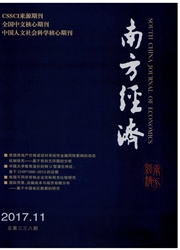

 中文摘要:
中文摘要:
基于双边贸易模型对本土市场效应的测算,忽略了“第三国效应”,导致实证结果难以精确的反映国际贸易的实际状况。本文在Behrens多国模型的基础上,加入了时间变量,构建了动态多边模型。利用1980--2003年CEPII—BACI数据库中ISIC一3数据和世界银行的“Trade and Production database”,采用广义最小二乘法(FGLS)和广义矩估计法(GMM),对中国制造业的行业需求份额和出口份额之间的关系进行了检验,测算了制造业整体及分行业的本土市场效应。研究结果表明:在多边框架中内需的作用被削弱,整体制造业出口存在弱本土市场效应;但是劳动密集型行业的本土市场效应得到强化。
 英文摘要:
英文摘要:
Estimates of HME based on bilateral trade model ignore "the third country effect", so the empirical results are difficult to reflect the actual situation of the international trade accurately. This paper establishes a dynamic multilateral model based on Behrens' multinational model by adding the time variables. We utilize ISIC -3 data in CEPII - BACI database and World Bank' s "Trade and Production database" from 1980 to 2003 to test the relationship between demand shares of China' s manufacturing industry and shares of exports by generalized least squares (FGLS) and generalized method of moments estimation method (GMM). This paper estimates HME of the overall manufacturing industry and the manufacturing sub - industry separately. The empirical results indicate that the role of domestic demand in multinational trade model was weaked. On the other hand, the overall manufacturing exports have weak HME while HME in labor -intensive industries should be strengthened.
 同期刊论文项目
同期刊论文项目
 同项目期刊论文
同项目期刊论文
 期刊信息
期刊信息
